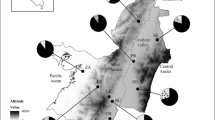Abstract
In this study, we attempted a population survey of spiders in peach orchards with and without pesticide application; however, we had difficulty discriminating them. To identify spiders, we determined the nucleotide sequences of a ca. 640-bp region in the mitochondrial cytochrome oxidase subunit I (COI) gene from 17 species belonging to eight families. To identify five wolf spiders (Araneae: Lycosidae), which are the most abundant spiders in peach orchards in Okayama Prefecture, PCR and restriction fragment length polymorphism were developed on the basis of the COI gene sequences. Population survey results suggest that pesticide applications adversely affect spider populations in peach orchards.


Similar content being viewed by others
References
Álvarez-Padilla F, Dimitrov D, Giribet G, Hormiga G (2009) Phylogenetic relationship of the spider family Tetragnathidae (Araneae, Araneoidea) based on morphological and DNA sequence data. Cladistics 25:109–146
Collins FH, Paskewitz SM (1996) A review of the use of ribosomal DNA (rDNA) to differentiate among cryptic Anopheles species. Insect Mol Biol 5:1–9
Greenstone MH, Rowley DL, Heimbach U, Lundgren JG, Pfannenstiel RS, Rehner SA (2005) Barcoding generalist predators by polymerase chain reaction: carabids and spiders. Mol Ecol 14:3247–3266
Hajibabaei M, Janzen DH, Burns JM, Hallwachs W, Hebert PDN (2006) DNA barcodes distinguish species of tropical Lepidoptera. Proc Natl Acad Sci USA 103:968–971
Hebert PDN, Cywinska A, Ball SL, de Waard JR (2003) Biological identifications through DNA barcodes. Proc R Soc Lond B Biol Sci 270:312–322
Hebert PDN, Penton EH, Burns JM, Janzen DH, Hallwachs W (2004) Ten species in one: DNA barcoding reveal cryptic species in the neotropical skipper butterfly Astraptes fulgerator. Proc Natl Acad Sci USA 101:14812–14817
Heinrichs EA, Aquino S, Chelliah S, Valencia SL, Reissig WH (1982a) Resurgence of Nilaparvata lugens (Stål) populations as induced by method and timing of insecticide applications in lowland rice. Environ Entomol 11:78–84
Heinrichs EA, Reissig WH, Valencia SL, Chelliah S (1982b) Rates and effect of resurgence-induced insecticides on populations of Nilaparvata lugens (Stål) (Homoptera: Delphacidae) and its predators. Environ Entomol 11:1269–1273
Kiritani K (1979) Pest management in rice. Annu Rev Entomol 24:279–312
Kiritani K, Kawahara S, Sasabe T, Nakasuji F (1972) Quantitative evaluation of predation by spiders on the green rice leafhopper, Nephotettix cincticeps Uhler, by a sight-count method. Res Popul Ecol 13:187–200
Lunt DH, Zhang D-X, Szymura JM, Hewitt GM (1996) The insect cytochrome oxidase I gene: evolutionary patterns and conserved primers for phylogenetic studies. Insect Mol Biol 5:153–165
Miller BR, Crabtree MB, Savage HM (1996) Phylogeny of fourteen Culex mosquito species, including the Culex pipiens complex, inferred from the internal transcribed spacers of ribosomal DNA. Insect Mol Biol 5:93–107
Mukabayire O, Boccolini D, Lochouarn L, Fontenille D, Besansky NJ (1999) Mitochondrial and ribosomal internal transcribed spacer (ITS2) diversity of the African malaria vector Anopheles fenestus. Mol Ecol 8:289–297
Nyffeler M, Benz G (1987) Spiders in natural pest control: a review. J Appl Entomol 103:321–339
Reissig WH, Heinrichs EA, Valencia SL (1982a) Insecticide-induced resurgence of the brown planthopper, Nilaparvata lugens, on rice varieties with different levels of resistance. Environ Entomol 11:165–168
Reissig WH, Heinrichs EA, Valencia SL (1982b) Effects of insecticides on Nilaparvata lugens and its predators: spiders, Microvelia atrolineata, and Cyrtorhinus lividipennis. Environ Entomol 11:193–199
Riechert SE, Lockley T (1984) Spiders as biological control agents. Annu Rev Entomol 29:299–320
Simon C, Frati F, Beckenbach A, Crespi B, Liu H, Flook P (1994) Evolution, weighting, and phylogenetic utility of mitochondrial gene sequences and a compilation of conserved polymerase chain reaction primers. Ann Entomol Am 87:651–701
Smith MA, Woodey NE, Janzen DH, Hallwachs W, Hebert PDN (2006) DNA barcodes reveal cryptic host-specificity within the presumed polyphagous members of a genus of parasitoid flies (Diptera: Tachinidae). Proc Natl Acad Sci USA 103:3657–3662
Tamura K, Dudley J, Nei M, Kumar S (2007) MEGA4: molecular evolutionary genetics analysis (MEGA) software version 4.0. Mol Biol Evol 24:1596–1599
Tanaka K, Endo S, Kazano H (2000) Toxicity of insecticides to predators of rice planthoppers: Spiders, the mirid bug and the dryinid wasp. Appl Entomol Zool 35:177–187
Tanikawa A (2010) A check list of Japanese spiders ver. 2010R1. http://www.asahi-net.or.jp/~DP7A-TNKW/japanDOC.doc
Thompson JF, Higgins FG, Gibson TG (1994) CLUSTAL W: improving the sensitivity of progressive multiple sequence alignment through sequence weighting, positions-specific gap penalties and weight matrix choice. Nucleic Acids Res 22:4673–4680
Wise DH (1993) Spiders in ecological webs. Cambridge University Press, Cambridge, p 328
Zhang D-X, Hewitt GM (1996) Assessment of the universality and utility of a set of conserved mitochondrial COI primers in insects. Insect Mol Biol 6:143–150
Acknowledgments
This study was supported by grants from the Ministry of Agriculture, Forestry and Fisheries (MAFF), the Wesco Scientific Promotion Foundation, and the Ohara Foundation for Agricultural Research. The authors also thank A. Tanikawa (The University of Tokyo) for identifying the samples.
Author information
Authors and Affiliations
Corresponding author
Rights and permissions
About this article
Cite this article
Sonoda, S., Yamashita, J., Kohara, Y. et al. Population survey of spiders using mt-DNA (COI) sequences in Japanese peach orchards. Appl Entomol Zool 46, 81–86 (2011). https://doi.org/10.1007/s13355-010-0011-0
Received:
Accepted:
Published:
Issue Date:
DOI: https://doi.org/10.1007/s13355-010-0011-0




